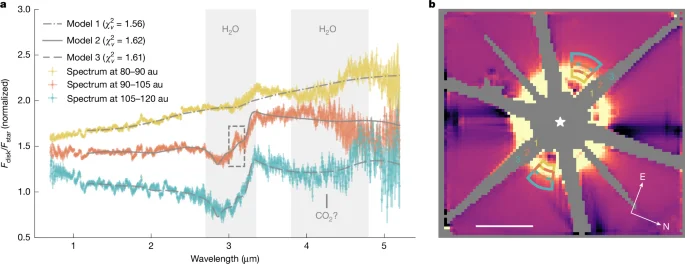
NASA’s Webb Telescope Uncovers Frozen Water in Distant Star System: A Glimpse into Our Solar System’s Past
In a groundbreaking discovery, NASA's James Webb Space Telescope has definitively detected crystalline water ice within a dusty debris disk orbiting a young, Sun-like star 155 light-years away. This marks the first time frozen water has been confirmed in such a system, offering a tantalizing glimpse into the potential origins of water on planets like our own.
The star, known as HD 181327, is significantly younger than our Sun, estimated to be around 23 million years old compared to the Sun's 4.6 billion years. This makes the system a valuable analog for studying the early stages of planetary formation. The presence of water ice, a vital ingredient for planet formation, suggests that similar processes may be unfolding around HD 181327, potentially leading to the creation of giant planets or even the delivery of water to rocky planets.

Chen Xie, lead author of the study from Johns Hopkins University, emphasized the significance of the finding, stating that Webb “unambiguously detected not just water ice, but crystalline water ice, which is also found in locations like Saturn’s rings and icy bodies in our solar system’s Kuiper Belt.” The crystalline structure, similar to that found in our own solar system, adds further weight to the idea that similar processes occur elsewhere in the universe.
The icy particles are mixed with fine dust, forming what scientists describe as tiny “dirty snowballs.” The majority of the water ice resides in the colder, outer regions of the debris disk, where it constitutes over 20% of the material. Closer to the star, the ice content decreases, likely due to the star's ultraviolet light vaporizing the ice. This distribution highlights the importance of temperature in maintaining water ice in these environments.
Noemí Pinilla-Alonso, a Spanish astronomer and co-author of the study, points out that “In this star, we are seeing our own past.” The debris ring surrounding HD 181327 closely resembles the Kuiper Belt in our solar system, a region populated by icy bodies and rocky debris. The ongoing collisions within the debris disk release water ice particles, providing a continuous source of material for detection by Webb.

This discovery wouldn't have been possible without the advanced capabilities of Webb's NIRSpec (Near-Infrared Spectrograph), which is incredibly sensitive to faint dust particles. As Christine Chen, a co-author from the Space Telescope Science Institute, noted, “What’s most striking is that this data looks similar to the telescope’s other recent observations of Kuiper Belt objects in our own solar system.”
The findings support the theory that Earth's water may have originated from similar extraterrestrial sources billions of years ago, delivered by comets and asteroids during a period of intense bombardment. This research paves the way for further investigations into the role of water ice in planetary formation and the potential for habitable worlds to arise around other stars.
What are the implications of this discovery for understanding the origins of life in the universe? Share your thoughts in the comments below.